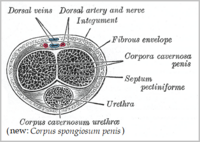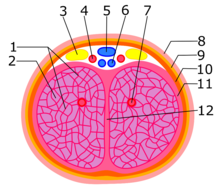Erectile tissue
Erectile tissue is tissue in the body with numerous vascular spaces, or cavernous tissue, that may become engorged with blood.[1][2] However, tissue that is devoid of or otherwise lacking erectile tissue (such as the labia minora, the vestibule/vagina and the urethra) may also be described as engorging with blood, often with regard to sexual arousal.[2]
In sex organs
This section is missing information about process of stimulation and erection of the clitoris and vestibular bulbs. (October 2023) |


Erectile tissue exists in
In the nose
Erectile tissue is present in the anterior part of the nasal septum[4] and is attached to the turbinates of the nose. The nasal cycle occurs as the erectile tissue on one side of the nose congests and the other side decongests. This process is controlled by the autonomic nervous system with parasympathetic dominance being associated with congestion and sympathetic with decongestion.[5][4] The time of one cycle may vary greatly between individuals with Kahana-Zweig et al. finding a range between 15 minutes and 10.35 hours though the average was noted as 2.15 ± 1.84 hours.[4]
Other types
Erectile tissue is also found in the nose (
References
- ^ "Erectile tissue". medical-dictionary.thefreedictionary.com. Retrieved June 28, 2012.
- ^ PMID 16536770.
- ISBN 978-1-4160-2328-9.
- ^ PMID 27711189.
- ^ PMID 6578066. Retrieved 14 May 2022.
